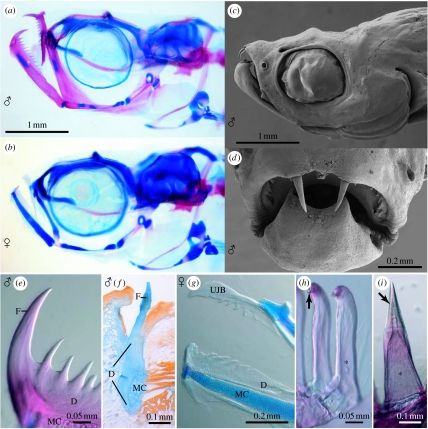Figure 2.
Danionella dracula. (a) Male, paratype, 16.2 mm (BMNH 2008.1.1.100-119), cleared and double stained, head skeleton, lateral view. (b) Female, paratype, 14.7 mm (BMNH 2008.1.1.100-119), cleared and double stained, head skeleton, lateral view. (c) Male, paratype, 14.8 mm (BMNH 2008.1.1.2-99), scanning electron micrograph, lateral view. (d) Same as (c), but close-up of mouth in anterior view. (e) Same as (a), but close-up of odontoid processes at anterior tip of lower jaw. (f) Male, 16.7 mm, histological section through canine-like odontoid process of the lower jaw, illustrating lack of pulp cavity and enameloid cusp. (g) Female, paratype, 15.4 mm (BMNH 2008.1.1.100-119), cleared and double stained, close-up of jaws with serrate edges on jaw bones and rudimentary canine-like odontoid processes, lateral view. (h) Same as (b), but close-up of pharyngeal jaw teeth with pulp cavity (marked with asterisk) and enameloid cusp (marked with arrow). (i) Hoplias malabaricus (BMNH 2005.7.5.778-863), 44 mm, cleared and double stained, close-up of individual premaxillary tooth with pulp cavity (marked with asterisk) and enameloid cusp (marked with arrow) for comparison with (e). D, dentary; F, fang-like odontoid process; MC, Meckel's cartilage; UJB, upper jaw bone.

